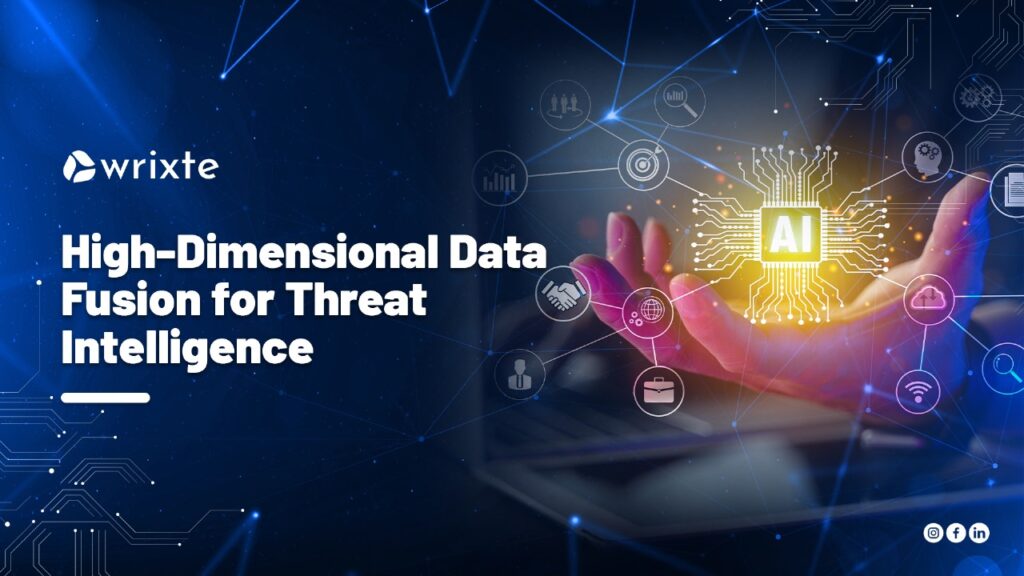The sophistication of modern cyber threats necessitates an equally advanced approach to threat detection and mitigation. High-dimensional data fusion represents a frontier in cybersecurity, leveraging complex algorithms and data integration techniques to produce actionable insights from vast and varied data sources.
In an era where cyber threats evolve at an unprecedented pace, high-dimensional data fusion emerges as a critical capability for advancing threat intelligence. This blog delves into the technical intricacies of high-dimensional data fusion, exploring how it integrates diverse data sources to provide a robust defense mechanism against sophisticated cyber threats.
High-Dimensional Data Fusion: A Brief Look
High-dimensional data fusion involves integrating data from multiple, often heterogeneous, sources to create a comprehensive and coherent understanding of the cybersecurity landscape. This process is pivotal for developing a multidimensional view of potential threats, enabling more precise and proactive threat intelligence.
Aspects of Data Fusion You Need to Know
To effectively utilize high-dimensional data fusion, several technical processes are involved. These processes ensure that the data is accurate, relevant, and useful for identifying and mitigating threats.
Data Preprocessing and Normalization: Before data can be fused, it must be preprocessed and normalized to ensure consistency across different formats and sources. This step involves techniques such as data cleaning, transformation, and feature extraction, which are essential for reducing noise and improving the quality of the input data.
Dimensionality Reduction: High-dimensional datasets often suffer from the curse of dimensionality, where the volume of data can overwhelm traditional analysis techniques. Dimensionality reduction methods, such as Principal Component Analysis (PCA) and t-Distributed Stochastic Neighbor Embedding (t-SNE), are employed to reduce the number of variables while preserving essential patterns and relationships.
Data Integration and Fusion Algorithms: Advanced algorithms such as Bayesian networks, Dempster-Shafer theory, and Kalman filters are used to integrate data from various sources. These algorithms are designed to handle uncertainty and incomplete data, providing a probabilistic framework for combining evidence from different sensors and sources.
Machine Learning for Pattern Recognition: Machine learning models, including supervised, unsupervised, and reinforcement learning, are applied to identify patterns and anomalies within the fused dataset. These models can detect subtle indicators of compromise that might be missed by traditional rule-based systems.
What are its Applications in Threat Intelligence?
The practical applications of high-dimensional data fusion in threat intelligence are vast. By integrating diverse data sources, organizations can significantly enhance their ability to detect and respond to threats.
Anomaly Detection
High-dimensional data fusion enables more effective anomaly detection by integrating data from network traffic, endpoint sensors, and external threat feeds. This integrated approach allows for the identification of deviations from normal behavior that could indicate a cyber attack.
Predictive Analytics
By combining historical data with real-time inputs, high-dimensional data fusion supports predictive analytics, enabling security teams to anticipate potential threats. Machine learning models trained on fused datasets can predict the likelihood of specific attack vectors, helping organizations to prioritize their defenses.
Real-Time Threat Intelligence
The ability to process and analyze high-dimensional data in real time is crucial for modern threat intelligence. Techniques such as in-memory computing and stream processing allow for the rapid analysis of data as it is generated, providing timely alerts and enabling swift responses to emerging threats.
Industry Impact and Statistics
The impact of high-dimensional data fusion on the cybersecurity industry is profound. Numerous studies and real-world implementations demonstrate its effectiveness in enhancing threat detection and response capabilities.
Increased Detection Rates
Organizations employing high-dimensional data fusion have reported significantly higher threat detection rates. According to a recent study by the Ponemon Institute, companies using advanced data fusion techniques saw a 40% increase in their ability to detect sophisticated threats compared to those using traditional methods.
Enhanced Response Times
Data fusion not only improves detection but also reduces response times. The same study found that organizations leveraging high-dimensional data fusion reduced their mean time to detect (MTTD) and mean time to respond (MTTR) by 30% and 25%, respectively.
Challenges and Future Directions
Despite its advantages, high-dimensional data fusion presents several challenges that must be addressed to maximize its potential. Understanding these challenges is crucial for future advancements.
Scalability
One of the primary challenges of high-dimensional data fusion is scalability. As the volume and variety of data continue to grow, developing scalable algorithms and architectures capable of handling massive datasets is essential.
Data Privacy and Security
Integrating data from multiple sources raises concerns about data privacy and security. Ensuring that data fusion processes comply with regulations such as GDPR and CCPA is critical for maintaining trust and legal compliance.
Advancements in AI and Machine Learning
Future advancements in AI and machine learning will further enhance the capabilities of high-dimensional data fusion. Techniques such as federated learning, which allows models to be trained across multiple decentralized datasets without sharing raw data, offer promising solutions for addressing privacy concerns while improving the accuracy and robustness of threat intelligence.
Conclusion
High-dimensional data fusion represents a significant advancement in the field of cybersecurity, providing the means to integrate and analyze diverse data sources for enhanced threat intelligence. As cyber threats continue to evolve, the ability to process and interpret high-dimensional data in real time will be critical for staying ahead of attackers. By leveraging advanced algorithms and machine learning techniques, organizations can achieve a more comprehensive and proactive approach to cybersecurity, ultimately leading to more robust defenses and quicker, more effective responses to threats.

